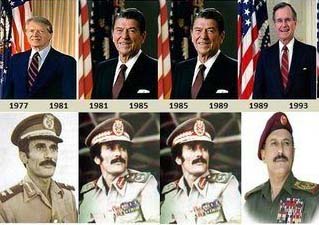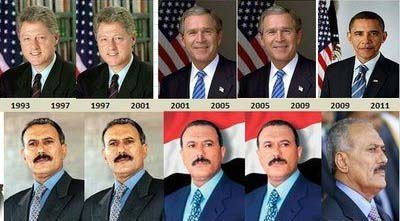

Very few people live for an entire century. I had a great aunt who was born in 1899 and lived into the first part of the 21st century, thus straddling three arbitrarily separated centuries. Imagine someone alive before Henry Ford’s “Tin Lizzy” and the airplane but around to see the cell phone. I realize that a third of a century is not a long period of time against the fourscore and ten of biblical proportions, but it is an eternity in political terms. Few leaders these days survive long enough, no matter how popular or powerful. One who has lasted 34 years is Yemen’s Ali Abdullah Salih, who started out in a military coup in 1978 in North Yemen, helped united north and south in 1990 and has ruled both since with the ongoing pretense of national elections. He is in theory allowed two more years in his last election cycle, which he had “reluctantly” agreed to run in. But in February, hundreds of thousands of Yemeni citizens thought enough was enough and Salih’s support has dwindled dramatically. In early June he was almost killed in a bomb blast, but he has now returned to Yemen and his presence makes the situation in the country even more volatile. In 34 years you make a lot of enemies, but Salih has been defiant, pulling out all the stops to protect his wealth and his power.
The best way to visualize 34 years is to look at the photographic trajectory of his power against the various American Presidents he has associated with as a fellow state leader. The extraordinary picture published by Yemen Press and shown above is quite striking. Salih’s military uniform gradually gave way to the business suit, but it was the massive amount of weapons rather than the ballot box that has kept him in power. Yemen has one of the highest percentages of military expenditures per total government budget in the world, up there near that of Israel. But, who exactly has Salih been afraid of over the years. The weak socialist state to the south? The Saudis to the north? The Somalis and Ethiopians across the horn? The far-off Israelis, who have enough problems with their bordering states? Or his own people? The fact that the vast majority of Yemenis want him out of power makes all but the last question above rhetorical.
I do not know who will be president after the next U.S. election cycle. It may be Obama again or another new face, but one thing is sure: Salih will not be around a year from now as the leader of Yemen. Predicting how long before he leaves is futile, but time is not on his side. The longer the stalemate continues, the more Yemen’s people suffer. With Salih gone there will be jubilation, but it will be a long haul for the Peninsula’s poorest and most populous country to get back on track.